
MILITARY
PERSONNEL
Armed Forces Should
Clarify Tattoo Policies’
Waiver Guidance
Report to Congressional Committees
August 2022
GAO-22-105676
United States Government Accountability Office
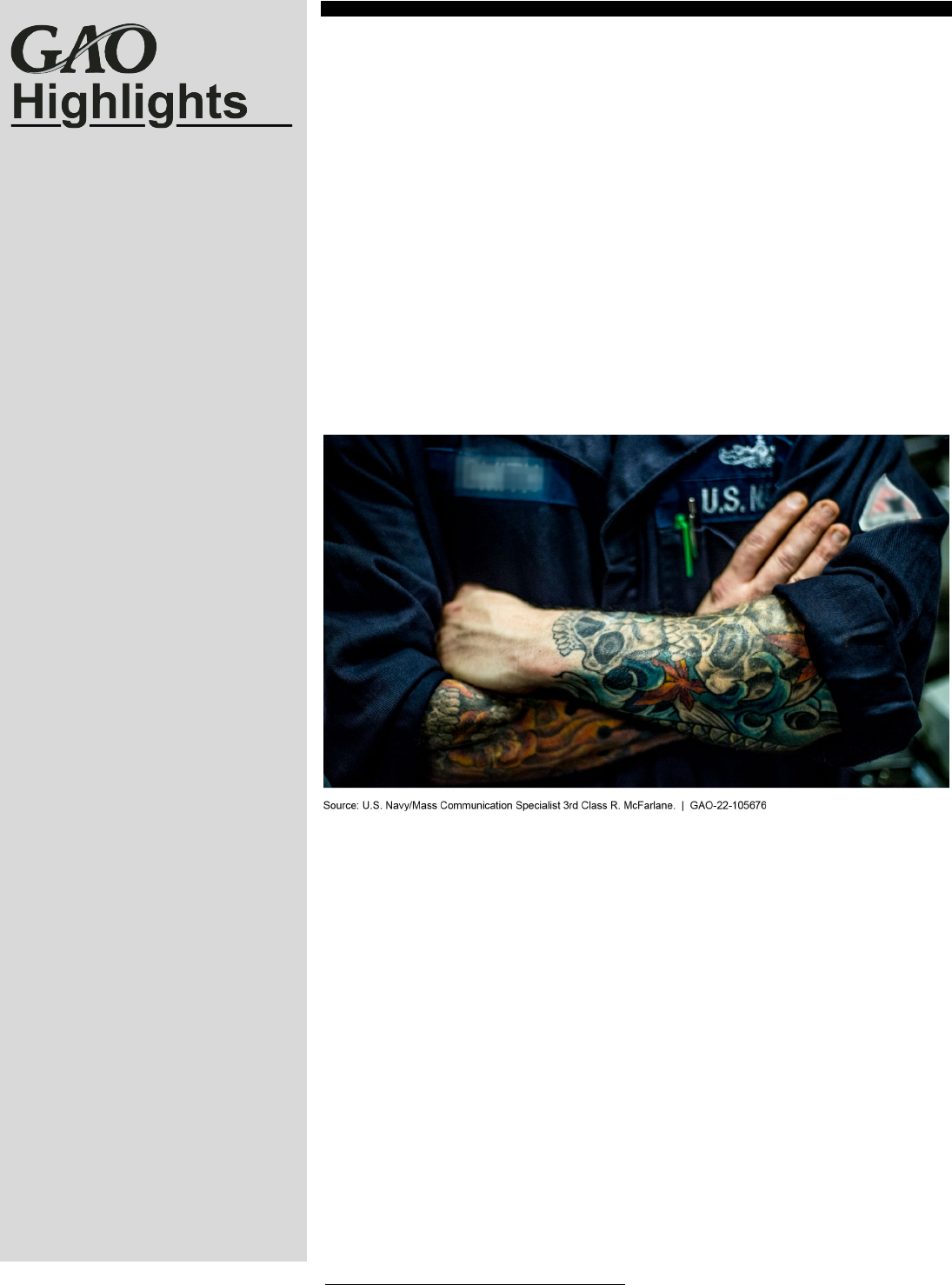
United States Government Accountability Office
Highlights of GAO-22-105676, a report to
congressional committees
August 2022
MILITARY PERSONNEL
Armed Forces Should Clarify Tattoo Policies' Waiver
Guidance
What GAO Found
The armed forces’ policies for tattoo permissions and restrictions all focus on the
content, size, and location of allowable tattoos. While the armed forces have
content prohibitions for tattoos, the policies have evolved and become less
restrictive regarding size and location. The current policies permit tattoos almost
anywhere on the body except for on the head and face.
Navy Service Member with Allowable Tattoos
Armed forces officials GAO interviewed stated that recruiting and retention data
do not include tattoo-specific data or other information that would allow an
assessment of whether tattoo policies have a direct effect on recruitment and
retention. Officials stated that tattoo policy updates are based on general
discussions and on limited assessments of tattoo-related information, such as
studies on tattoo prevalence among youth.
Most armed forces allow waivers (i.e., exceptions) for certain unauthorized
tattoos, usually related to their size or location, for recruits and service members.
Although each of the armed forces allows waivers for certain tattoo restrictions
for recruits, the policies do not always mention or provide clear guidance on the
requirements for these waivers. In addition, each armed force, except for the
Navy, allows waivers for certain tattoo restrictions for service members, but their
respective policies generally do not document this possibility clearly. Clear
guidance on waivers for unauthorized tattoos would provide consistent
information about requirements for waiver requests and conditions for approval.
This could clarify whether tattoo prevalence affects future or continued military
service.
View GAO-22-105676. For more information,
contact
Brenda S. Farrell at (202) 512-
3604 or
.
Why GAO Did This Study
The House Committee on Armed
Services
and the military services have
acknowledged
recent challenges in
recruiting, which they have attributed to
a number of social and economic
factors.
Tattoo prevalence among
American youth has increased,
and
Congress has expressed interest in
the
effect the
armed forces’ tattoo policies
have on recrui
tment and retention.
The
National Defense Authorization
Act for Fiscal Year 2022
includes a
provision for GAO to
review the armed
forces’
tattoo policies. GAO examined
the extent to which (1)
tattoo policies
exist for potential and current members
of the
armed forces, (2) the armed
forces assess any effects of their tattoo
policies on recruitment and retention of
members, and (3) the armed forces
have waiver processes for
unauthorized tattoos.
GAO
included the
Army, Marine Corps,
Navy
, Air Force, and Space Force
within the Department of Defense
(DOD)
, and the Coast Guard
within the
Department of Homeland Security
(DHS). GAO
analyzed their tattoo
policies for potential recruits and
current service members, including
enlisted
personnel and officers.
What GAO
Recommends
GAO
recommends that each of the six
armed force
s updates its tattoo policy,
as appropriate
, to better ensure that it
clearly documents whether waivers are
availab
le for recruits and service
members
; and provides
clear guidance
on
eligible tattoos and
requirements for
requesting a waiver
, among other
things
. DOD and the military services
generally agreed, and
DHS agreed,
with
the recommendations.

Page i GAO-22-105676 Military Personnel
Letter 1
Policies Focus on Tattoo Content, Size, and Location and Have
Become Less Restrictive 4
Limited Assessments Have Been Conducted on Tattoo Policies’
Effect on Recruitment and Retention 6
Opportunities Exist to Clarify Waiver Policies for Unauthorized
Tattoos 9
Conclusions 13
Recommendations for Executive Action 13
Agency Comments and Our Evaluation 14
Appendix I Comments from the Department of Defense 17
Appendix II Comments from the Department of Homeland Security 20
Appendix III GAO Contact and Staff Acknowledgments 23
Tables
Table 1: Armed Forces’ Policies on Tattoo Waivers for Recruits 10
Table 2: Armed Forces’ Policies on Tattoo Waivers for Service
Members 11
Figure
Figure 1: Evolution of the Armed Forces’ Policies on Tattoos for
Recruits and Service Members 5
Contents

Page ii GAO-22-105676 Military Personnel
Abbreviations
DOD Department of Defense
JAMRS Joint Advertising, Market Research and Studies
This is a work of the U.S. government and is not subject to copyright protection in the
United States. The published product may be reproduced and distributed in its entirety
without further permission from GAO. However, because this work may contain
copyrighted images or other material, permission from the copyright holder may be
necessary if you wish to reproduce this material separately.

Page 1 GAO-22-105676 Military Personnel
441 G St. N.W.
Washington, DC 20548
August 17, 2022
The Honorable Jack Reed
Chairman
The Honorable James M. Inhofe
Ranking Member
Committee on Armed Services
United States Senate
The Honorable Adam Smith
Chairman
The Honorable Mike Rogers
Ranking Member
Committee on Armed Services
House of Representatives
The House Committee on Armed Services and the military services have
acknowledged recent challenges in recruiting for military service.
1
The
Department of Defense (DOD) and the military services have attributed
these challenges to a number of social and economic factors, such as low
unemployment rates, competitive labor markets, limited eligibility among
the youth population, and the COVID-19 pandemic.
The House Committee on Armed Services cited concerns that tattoo
restrictions may be affecting the military services’ ability to recruit and
retain talent. For example, a report accompanying a bill for the National
Defense Authorization Act for Fiscal Year 2022 expressed concern that
potential enlistees’ tattoos had become a deterrent to meeting recruitment
goals in previous years.
2
Studies commissioned by DOD have suggested
1
H.R. Rep. No. 117-118 at 134 (2021); Department of Defense Announces Recruiting and
Retention Numbers for Fiscal Year 2022 thru March 2022 (2022). U.S. Army Recruiting
Command, Facts and Figures, Recruiting Challenges,
https://recruiting.army.mil/pao/facts_figures/, (accessed April 4, 2022).
2
H.R. Rep. No. 117-118 at 134 (2021), See also, Military Personnel Talent Management
Modernization and the Effects of Legacy Policies: Hearing before the Subcomm. on
Military Personnel of the House Comm. on Armed Services, 117th Cong. (Feb. 8, 2022).
Letter

Page 2 GAO-22-105676 Military Personnel
that the prevalence of young people under 24 years old with tattoos may
have risen.
3
Section 586 of the National Defense Authorization Act for Fiscal Year
2022 included a provision that we review the armed forces’ tattoo policies
and related effects on recruitment and retention.
4
This report examines
the extent to which (1) tattoo policies exist for potential and current
members of the armed forces, (2) the armed forces assess any effects of
their tattoo policies on recruitment and retention of members, and (3) the
armed forces have waiver processes for unauthorized tattoos.
5
To address these objectives, we analyzed the armed forces’ current
tattoo policies for recruits and service members, including both enlisted
personnel and officers, and compared the policies with previous policies
to determine how they have changed.
6
We reviewed armed forces’
information on recruitment and retention for fiscal years 2017 through
2022, as available. We also reviewed tattoo-related studies and
3
Joint Advertising, Market Research and Studies, Joint Advertising, Market Research and
Studies 2014 General Youth Survey (2014). The survey includes 16- to 24-year old
respondents. CNA Analysis and Solutions, Tattoo trends in America’s youth and Marine
Corps tattoo policy (Nov. 1, 2018). The CNA study includes 18- to 24-year olds.
4
Pub. L. 117-81, § 586 (2021). For the purposes of this report, we refer collectively to the
Army, Marine Corps, Navy, Air Force, Space Force, and Coast Guard as the “armed
forces.”
5
For the purposes of this report, we refer to exceptions to the armed forces’ policies as
“waivers.”
6
For the purposes of this report, “recruits” include potential recruits, applicants, or
individuals in a military service’s pre-enlistment or commissioning process. We reviewed
the following current armed forces’ tattoo policies: Army Regulation 670-1, Wear and
Appearance of Army Uniforms and Insignia (Jan. 26, 2021); Army Directive 2022-09,
Soldier Tattoos (June 22, 2022); NAVPERS 15665J, United States Navy Uniform
Regulations (2021); Marine Corps Bulletin 1020, Marine Corps Tattoo Policy (Oct. 29,
2021); Department of the Air Force Instruction 36-2903, Dress and Personal Appearance
of United States Air Force and United States Space Force Personnel (Feb. 7, 2020)
(incorporating Change 4, Apr. 12, 2022); Space Force Guidance Memorandum 2022-36-
01, Space Force Guidance Memorandum Establishing U.S. Space Force Dress and
Appearance Standards (May 23, 2022); and U.S. Coast Guard Commandant Instruction
1000.1E, Tattoo, Body Marking, Body Piercing, and Mutilation Standards (Apr. 21, 2022).
Previous armed forces’ tattoo policies include the following: Army Regulation 670-1, Wear
and Appearance of Army Uniforms and Insignia (Mar. 31, 2014); NAVADMIN 110/06,
Navy Uniforms (Apr. 21, 2006); Marine Corps Order 1020.34H, Marine Corps Uniform
Regulations (May 1, 2018); Air Force Instruction 36-2903, Dress and Personal
Appearance of Air Force Personnel (July 18, 2011); and U.S. Coast Guard Commandant
Instruction 1000.1C, Tattoo, Body Marking, Body Piercing, and Mutilation Policy (Dec. 29,
2016).

Page 3 GAO-22-105676 Military Personnel
information used by the armed forces.
7
We compared the armed forces’
tattoo policies on waivers for unauthorized tattoos with federal standards
for internal control.
8
Specifically, we compared the policies with the
internal controls on communicating the necessary quality information to
achieve an entity’s objectives. We also conducted interviews with DOD
and armed forces officials to gather information about topics covered
within this review.
9
We conducted this performance audit from February 2022 to August 2022
in accordance with generally accepted government auditing standards.
Those standards require that we plan and perform the audit to obtain
sufficient, appropriate evidence to provide a reasonable basis for our
findings and conclusions based on our audit objectives. We believe that
the evidence obtained provides a reasonable basis for our findings and
conclusions based on our audit objectives.
7
Armed forces officials we interviewed identified relevant tattoo-related studies, surveys,
and assessments that they used to help inform their tattoo policy changes or discussions.
We reviewed methodological information for these studies as available.
8
GAO, Standards for Internal Control in the Federal Government, GAO-14-704G
(Washington, D.C.: September 2014).
9
We conducted interviews with officials from the following DOD entities: the Office of the
Deputy Assistant Secretary of Defense for Military Personnel Policy (which falls under the
Offices of the Assistant Secretary of Defense for Manpower and Reserve Affairs and the
Under Secretary of Defense for Personnel and Readiness); the armed forces’ offices
responsible for tattoo policy, waivers, and recruitment and retention; the U.S. Military
Entrance Processing Command; and DOD’s Joint Advertising, Market Research and
Studies.

Page 4 GAO-22-105676 Military Personnel
The armed forces have all established tattoo policies that are similar in
their focus on the content, size, and location of tattoos.
10
With respect to
the size and location of tattoos, the armed forces’ policies became less
restrictive during 2016 through June 2022.
Content. All of the armed forces’ policies prohibit tattoos that are
prejudicial to good order and discipline, or that are of a nature to bring
discredit to their service. Specifically, all of the policies prohibit content
related to extremism, sexism, and racism.
11
Additionally, the Navy, Marine
Corps, and Coast Guard also prohibit content related to drugs and gangs,
and the Air Force prohibits content related to gangs.
Size and location. The armed forces have made the policies less
restrictive regarding the size and location of tattoos. Specifically, the
current tattoo policies have evolved to permit tattoos for recruits and
service members almost anywhere on the body, except for on the head
and face (see fig. 1).
12
10
The Army, Navy, and Air Force have established dress, appearance, or uniform
standards—referred to as “appearance policies” for the purposes of this report—that
address tattoo permissions and restrictions for potential recruits and service members.
The Marine Corps and Coast Guard have stand-alone tattoo policies. The Army provided
an update to its policy with an Army directive in June 2022. The Marine Corps provided an
update to its policy with a Marine Corps bulletin in October 2021. In May 2022, the
Department of the Air Force issued a Space Force dress and appearance guidance
memorandum (addressing tattoos and other dress and appearance policies) that it uses in
conjunction with the Air Force’s dress and appearance policy.
The Army’s directive is rescinded on publication of the revised regulation. The Marine
Corps’ bulletin and the Space Force’s memorandum expire after 1 year or whenever the
contents are incorporated into permanent policy. There is no overarching Office of the
Secretary of Defense policy related to dress and appearance or tattoos.
11
A DOD instruction with guidelines for handling protest, extremist, and criminal gang
activities among members of the armed forces includes restrictions on related tattoos.
Department of Defense Instruction 1325.06, Handling Protest, Extremist, and Criminal
Gang Activities Among Members of the Armed Forces (Nov. 27, 2009) (incorporating
Change 2, Dec. 20, 2021).
12
The Navy’s, Air Force’s, and Space Force’s tattoo policies permit cosmetic tattoos to
correct medical conditions. Additionally, the Army’s, Air Force’s, Space Force’s, and Coast
Guard’s tattoo policies permit cosmetic tattoos, including permanent facial makeup (e.g.,
eyebrows and eyeliner). The Marine Corps’ tattoo policy does not mention cosmetic
tattoos.
Policies Focus on
Tattoo Content, Size,
and Location and
Have Become Less
Restrictive
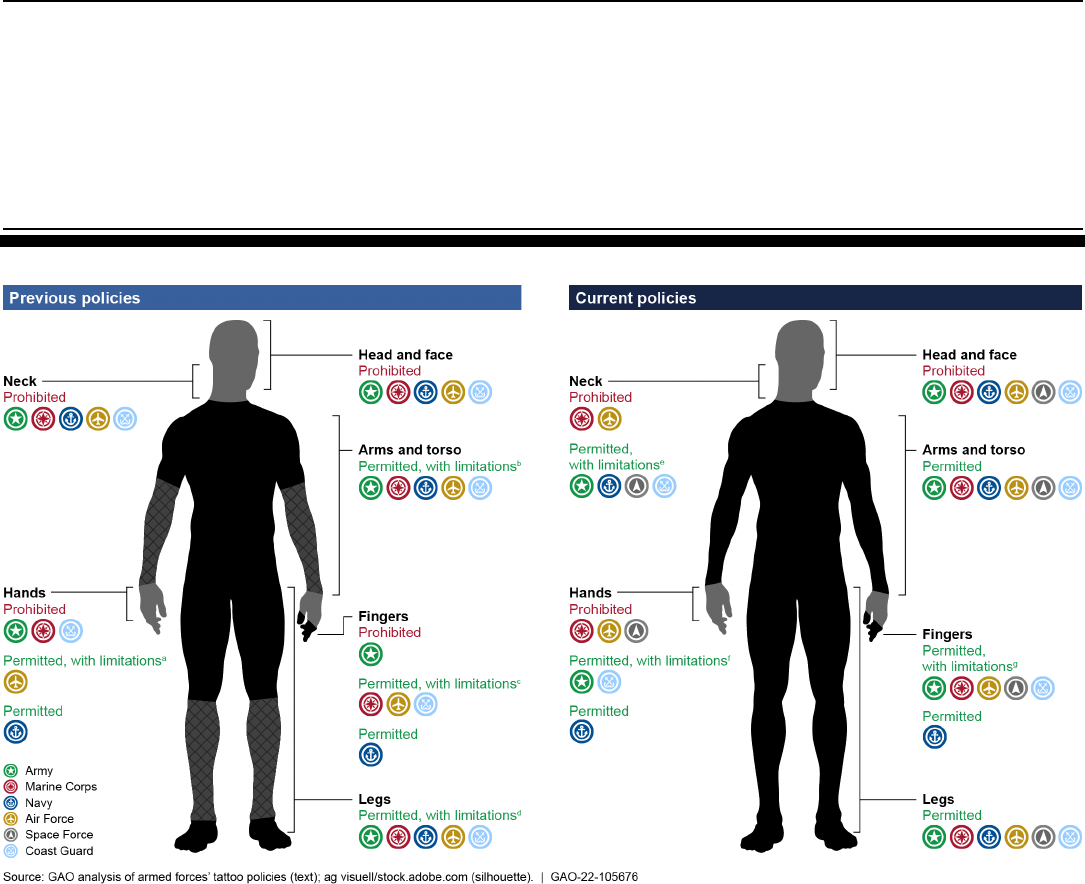
Page 5 GAO-22-105676 Military Personnel
Figure 1: Evolution of the Armed Forces’ Policies on Tattoos for Recruits and Service Members
Note: Each of the armed forces’ tattoo policies represented in this figure went into effect in different
years. For previous policies: Army Regulation 670-1 (2014); NAVADMIN 110/06 (2006); Marine
Corps Order 1020.34H (2018); Air Force Instruction 36-2903 (2011); U.S. Coast Guard Commandant
Instruction 1000.1C (2016). The Space Force is not included in the Air Force’s previous tattoo policy
because the Space Force was not established until 2019. From 2020 through present, the Air Force’s
tattoo policy applies to Space Force personnel, and is now applied in conjunction with the Space
Force memorandum of May 2022. For current policies: Army Regulation 670-1 (2021); Army Directive
2022-09 (2022); NAVPERS 15665J (2021); Marine Corps Bulletin 1020 (2021); Department of the Air
Force Instruction 36-2903 (2022); Space Force Guidance Memorandum 2022-36-01 (2022); U.S.
Coast Guard Commandant Instruction 1000.1E (2022).
a, b, c, d
The Air Force permitted hand, arm, torso, finger, and leg tattoos in a previous policy as long as
tattoos exceeding 25 percent of the exposed body part were not visible while a service member was
wearing any uniform combination.
b, d
The Army, Navy and Marine Corps permitted lower arm and lower leg tattoos but with limitations.
Specifically, the Army permitted service members to have no more than four visible tattoos (smaller
than the service member’s hand) below the elbow and below the knee. In the Navy, tattoos in these
areas visible when wearing a short-sleeve uniform shirt could not be larger than the service member’s
hand. The Marine Corps permitted tattoos in these areas but limited them to one of the following: (1)
a single tattoo that could be covered by the service member’s hand, (2) a single collection of tattoos
that could be covered by the service member’s hand, or (3) a single band tattoo.
c
The Marine Corps permitted one ring tattoo on one hand. The Coast Guard permitted one ring tattoo
on one finger of each hand.
e
The Army permits one tattoo on the back of the neck not to exceed 2 inches and permits one tattoo
behind the ear not to exceed 1 inch. The Navy and Space Force permit one tattoo on the neck or

Page 6 GAO-22-105676 Military Personnel
behind the ear not to exceed 1 inch. The Coast Guard permits one tattoo behind the ear that is no
larger than 1 inch.
f
The Army permits tattoos on each hand (including the palm) no larger than 1 inch. The Coast Guard
permits a single tattoo on each hand, no larger than 1 inch.
g
The Army, Marine Corps, and Space Force permit one ring tattoo on one finger of each hand. The
Air Force permits one ring tattoo on one hand. The Coast Guard permits one tattoo on one finger of
each hand.
An example of a significant change relates to a large collection of tattoos
on the legs or arms (i.e., a sleeve tattoo). Specifically:
• In May 2018, the Marine Corps tattoo policy did not allow elbow
tattoos, knee tattoos, or sleeve tattoos. However, in October 2021, the
Marine Corps updated its tattoo policy to permit tattoos anywhere
except on the head, neck, face, and parts of the hands.
• In January 2017, Air Force eliminated its restriction on tattoos which
covered more than 25 percent of a visible body part. Prior to this,
hand, arm, torso, and leg tattoos were permitted by a previous Air
Force tattoo policy as long as they did not exceed 25 percent of the
visible body part when a service member was wearing any or all
uniform combinations.
• In March 2014, the Army tattoo policy did not allow sleeve tattoos
below the elbow or the knee. However, the Army updated its tattoo
policy in May 2017 to allow service members to have sleeve tattoos.
This more permissive rule on sleeve tattoos remains valid.
Officials from each of the armed forces stated that they generally do not
use data on their respective tattoo policies to assess their performance in
meeting recruiting and retention goals. These officials stated that the
forces’ recruiting and retention data do not include tattoo-specific data or
other information that would allow an assessment as to whether their
tattoo policies have a direct effect on recruitment and retention.
13
However, according to officials from each of the armed forces, they have
based some tattoo policy updates on general discussions and on limited
assessments of tattoo-related information. For example:
• Joint Advertising, Market Research and Studies (JAMRS). Army
officials stated that findings from JAMRS—DOD’s program for joint
13
Because recruitment and retention data do not include tattoo-specific indicators, we
could not directly assess the effects of the armed forces’ tattoo policies on recruitment and
retention. However, we did evaluate the extent to which the armed forces assess the
effects of tattoo policies on recruitment and retention.
Limited Assessments
Have Been
Conducted on Tattoo
Policies’ Effect on
Recruitment and
Retention

Page 7 GAO-22-105676 Military Personnel
military advertising and market research—led them to change the
Army’s tattoo policy in 2017 to become less restrictive. According to
JAMRS officials, in 2013, a research request by one of the military
services initiated the inclusion of two tattoo-related questions in the
JAMRS’ 2014 general youth survey to gather information on whether
youth have tattoos and, if so, where the tattoos are located. The 2014
JAMRS research found that when looking within the eligible youth
(ages 16–24) population, changing from a more restrictive to a less
restrictive tattoo policy would increase the recruiting pool by
approximately 6 percent of the eligible youth market. Further, JAMRS
repeated the tattoo questions in its 2020 general youth survey and
found that 49 percent of youth had a tattoo on the forearm and 25
percent of youth had a tattoo below the knee. According to JAMRS
officials, the results of both the 2014 and 2020 general youth surveys
were summarized and distributed to all of the military services.
• Air Force Recruiting Service surveys. Air Force officials said they
used two Air Force Recruiting Service surveys to support the removal
of certain tattoo restrictions in Air Force policy. In fall 2016, the Air
Force Recruiting Service found, based on survey information collected
from recruiters, that a number of potential recruits had tattoos that
required review or disqualified them due to failure to meet Air Force
standards. Air Force officials stated that they used this information to
support a policy update in 2017 permitting service members to have
sleeve tattoos on their arms and large collections of tattoos on parts of
their bodies where tattoo collections were previously prohibited. The
officials stated that the Air Force also updated its tattoo policy in April
2022 after an Air Force Recruiting Service survey in 2021 found that
additional individuals may have qualified for Air Force service if the Air
Force policy had been changed to allow hand tattoos.
• Coast Guard RAND study. In 2021, RAND conducted a study to
improve the representation of women and racial and ethnic groups
among Coast Guard service members.
14
Coast Guard officials stated
that, in response to this study, a task force looked at potential
recruiting barriers and worked with the Coast Guard Recruiting
Command to update the tattoo policy and to make other changes to
enhance recruiting efforts.
• Tattoo waiver data. Navy officials stated that they have used waiver
data to inform policy changes related to tattoo permissions for
14
Homeland Security Operational Analysis Center operated by the RAND Corporation,
Improving the Representation of Women and Racial/Ethnic Minorities Among U.S. Coast
Guard Active-Duty Members (2021).

Page 8 GAO-22-105676 Military Personnel
recruits, but have not used waiver data to examine tattoo policy
specific to retention or reenlistment. For example, Navy officials stated
that leadership observed that recruits were declined because of
unauthorized tattoos deemed ineligible for waivers. Additionally, Coast
Guard officials stated that they collect and maintain data on recruits
who request tattoo waivers to gain entry into the service, for use by
policy makers.
15
DOD and Coast Guard recruitment and retention active component data
show that the armed forces generally met recruitment and retention goals
for fiscal years 2017 through 2021, with a few exceptions.
16
Through nine
months of fiscal year 2022 (October 2021–June 2022), the Army and
Navy did not meet their recruiting goals, and the military services met
their retention goals.
17
In 2022, DOD reported that its broader recruiting
market continues to deteriorate. DOD specifically stated that its recruiting
challenges include youth’s lack of interest in military service. U.S. Army
Recruiting Command stated that among the recruiting challenges is the
most challenging labor market since the inception of the all-volunteer
force.
18
In addition, DOD officials attributed current recruiting challenges
to the following:
15
Army, Marine Corps, and Air Force officials stated that they do not use waiver data to
make decisions related to updating tattoo policies for the recruitment and retention of
service members.
16
According to DOD’s recruiting and retention press releases, for fiscal year 2018 the
Army did not meet its recruiting goal. In fiscal year 2019, the Marine Corps was slightly
below its retention goal. In fiscal year 2021, the Navy and Marine Corps were slightly
below their respective retention goals.
https://www.defense.gov/News/Releases/Release/Article/1691314/department-of-defense
-announces-fiscal-year-2018-recruiting-and-retention-numbe/ (accessed June 3, 2022);
https://prhome.defense.gov/Portals/52/September%202019.pdf (accessed June 3, 2022);
DOD, Department of Defense Announces Recruiting and Retention Numbers for Fiscal
Year 2021 (2021). According to Coast Guard officials, the Coast Guard did not meet all of
its recruitment and retention goals for fiscal years 2019 through 2021. The Space Force
was created in 2019 and started collecting recruitment and retention data in 2022. Armed
forces’ recruitment and retention data are being collected for fiscal year 2022.
17
DOD, Department of Defense Announces Recruiting and Retention Numbers for Fiscal
Year 2022 thru June 2022 (2022). DOD reported that the military services have generally
exhibited strong retention, with all military services exceeding retention goals. According
to DOD, the military services have used incentives to maintain retention for the active
component. Coast Guard officials stated that recruitment and retention data for fiscal year
2022 are not yet available because the fiscal year is ongoing.
18
U.S. Army Recruiting Command, Facts and Figures, Recruiting Challenges,
https://recruiting.army.mil/pao/facts_figures/, (accessed April 4, 2022).

Page 9 GAO-22-105676 Military Personnel
• broad social and economic factors, such as a lack of qualified military
applicants and historically low propensity-to-serve rates among
today’s youth;
• a decreasing number of individuals that favor military service, together
with an economy offering an increasing amount of hiring bonuses for
civilian jobs;
• lower accessibility to schools and less in-person recruiting due to
COVID-19; and
• the effects of a U.S. labor shortage.
Most armed forces allow waivers (i.e., exceptions to tattoo policies) for
certain unauthorized tattoos, usually related to their size or location, for
recruits and current service members. However, some of the armed
forces’ relevant policies do not directly address whether waivers for
unauthorized tattoos are available for recruits, and only one armed force’s
policy directly addresses whether waivers for unauthorized tattoos are
available for service members. In addition, most of the armed forces’
tattoo policies do not include clear information on the tattoos or
individuals eligible for waivers, requirements for waiver requests and
conditions for approval, or specifics on who has authority to approve
tattoo waivers.
Waivers for recruits. Each of the armed forces allows waivers for certain
tattoo restrictions for recruits, but the policies do not always mention or
provide clear guidance on these waivers (see table 1).
Opportunities Exist to
Clarify Waiver
Policies for
Unauthorized Tattoos

Page 10 GAO-22-105676 Military Personnel
Table 1: Armed Forces’ Policies on Tattoo Waivers for Recruits
Armed force
Tattoo waiver (including
waiver approval authority)
clearly stated in tattoo section
of appearance policy?
Tattoos eligible for waivers clearly
specified in tattoo section of
appearance policy?
Requirements for requests and
conditions for waiver approval
clearly specified in tattoo section
of appearance policy?
Army
Yes
Suggests they are available outside
authorized areas
No
Marine Corps
a
Yes
Yes, outside authorized areas
No
Navy
Yes
No
No
Air Force
Yes, only for exceptionally
qualified recruits in critical,
understaffed career fields
Yes, an additional hand tattoo
No
Space Force
b
Yes, only for exceptionally
qualified recruits in critical,
understaffed career fields
Yes, an additional hand tattoo
No
Coast Guard
No
No
No
Source: GAO analysis of the armed forces’ documents. | GAO-22-105676
Note: Armed forces’ policies on dress, appearance, or uniform standards or their stand-alone tattoo
policies—referred to as “appearance policies” for the purposes of this table—address tattoo
permissions and restrictions for each armed force.
a
The Marine Corps bulletin addressing tattoos will be in effect until October 2022 or until incorporated
into permanent policy, whichever occurs sooner.
b
In May 2022, the Department of the Air Force issued a Space Force guidance memorandum (in
effect for 1 year or until incorporated into permanent policy, whichever occurs sooner) related to
appearance, including tattoos. However, the memorandum is not all-inclusive, and the Space Force
uses current Air Force policy for those areas, such as waivers, not addressed in the memorandum.
This memorandum is part of the Space Force’s “appearance policy.”
The Army, Navy, and Air Force discuss waivers for recruits in the tattoo-
specific sections of their appearance policies. An October 2021 Marine
Corps bulletin, updating the Marine Corps’ tattoo policy, states that
recruits can request a waiver, although the bulletin also states that such
waivers are unlikely to be approved.
19
The Navy and the Marine Corps
have recruit-specific guidance that provides additional information on
waivers for tattoos. Navy officials also stated that, in March 2022, the
Navy expanded its waiver availability for recruits to include more locations
on the neck and ear; however, they stated that this expansion is not yet
included in Navy policy or other guidance documents. The Coast Guard’s
policy discusses that authority for tattoo consideration for recruits resides
with the relevant command structure, but it does not specifically state a
19
The Marine Corps bulletin will be in effect until October 2022 or until incorporated into
permanent policy, whichever occurs sooner. Marine Corps officials stated that they expect
the bulletin to be extended until the contents are incorporated into permanent policy.

Page 11 GAO-22-105676 Military Personnel
waiver is available for tattoos. However, Coast Guard officials confirmed
that recruits are eligible for waivers for tattoos.
Waivers for service members. Each of the armed forces, except for the
Navy, allows waivers to certain tattoo restrictions for service members,
although their respective appearance policies generally do not document
this possibility clearly. However, the Marine Corps states explicitly in its
policy that waivers for unauthorized tattoos are available (see table 2).
Table 2: Armed Forces’ Policies on Tattoo Waivers for Service Members
Armed force
Tattoo waiver (including waiver
approval authority) clearly stated in
tattoo section of appearance
policy?
Tattoos eligible for waivers
clearly specified in tattoo
section of appearance policy?
Requirements for requests
and conditions for waiver
approval clearly specified in
tattoo section of appearance
policy?
Army
No
a
No
No
Marine Corps
b
Yes
Yes, outside authorized areas
No
Navy
No
Not applicable
Not applicable
Air Force
No
No
No
Space Force
c
No
No
No
Coast Guard
No
No
No
Source: GAO analysis of the armed forces’ documents. | GAO-22-105676
Note: Armed forces’ policies on dress, appearance, or uniform standards or their stand-alone tattoo
policies—referred to as “appearance policies” for the purposes of this table—address tattoo
permissions and restrictions for each armed force.
a
Army policy has one narrow waiver available to service members. That is, a member whose tattoo
was deemed appropriate upon entry, but is later determined to violate the policy, may request a
waiver through command channels.
b
The Marine Corps bulletin will be in effect until October 2022 or until incorporated into permanent
policy, whichever occurs sooner.
c
In May 2022, the Department of the Air Force issued a Space Force guidance memorandum (in
effect for 1 year or until incorporated into policy, whichever occurs sooner) related to appearance,
including tattoos. However, the memorandum is not all-inclusive, and the Space Force uses current
Air Force policy for those areas, such as waivers, not addressed in the memorandum. This
memorandum is part of the Space Force’s “appearance policy.”
The Marine Corps policy states that service members can request a
waiver for tattoos outside an authorized location, but notes that the
request is unlikely to be approved. Army, Air Force, and Coast Guard
officials stated that service members can request waivers to the tattoo
policy.
20
The Navy does not currently offer waivers for service members’
20
Air Force officials’ statement applies to service members from both the Air Force and
Space Force.

Page 12 GAO-22-105676 Military Personnel
unauthorized tattoos, but Navy officials indicated possible changes to the
tattoo policy for service members are under consideration.
Although waiver availability for service members is generally not clearly
stated in policies, most armed forces’ policies allow for, or officials stated
that they allow for, waivers. Specifically, they stated that service members
either should follow standard procedures for policy-related requests or
should contact their respective chains of command to request waivers to
tattoo policy. For example, the Army’s appearance policy states that
service members should route any waiver requests through the
appropriate command. Similarly, the Air Force’s and Coast Guard’s
appearance policies provide an email address for requesting an exception
to anything within the policy, which would include a waiver for tattoos.
Marine Corps officials confirmed that the command structure has the
authority to approve waivers. Officials from four armed forces stated that
current waiver approval processes include decision-makers’ consideration
of the “whole person,” which would include evaluation of factors beyond
the tattoo.
Waivers for content. Waivers are not generally available for tattoos with
unauthorized content. Marine Corps policy states that waivers for
unauthorized tattoos are available only for those tattoos outside an
allowed location. The Air Force policy specifically states that waivers for
recruits are not available for tattoo content, and the Navy policy states
that it does not grant waivers for prohibited content. The Army policy
provides the option for recruits to request waivers for unauthorized tattoo
locations. Navy and Air Force officials confirmed that tattoo content is not
eligible for a waiver.
According to Standards for Internal Control in the Federal Government,
effective information and communication are vital for an entity to achieve
its objectives.
21
These standards state that management should internally
and externally communicate the necessary quality information to achieve
the entity’s objectives. This includes considering who needs the
information, how best to communicate it, and how to make the information
readily available to them.
Clear policies on waiver availability for unauthorized tattoos—such as
what types of waivers are available, to whom, and under what
21
GAO, Standards for Internal Control in the Federal Government, GAO-14-704G
(Washington, D.C.: September 2014).

Page 13 GAO-22-105676 Military Personnel
conditions—would provide decision-makers, such as commanders;
recruiters, who interface with potential recruits; and potential waiver
applicants with consistent information about requirements for waiver
requests and conditions for approval. In addition, clarified policies could
enhance awareness among commanders, recruiters, eligible recruits, and
current service members that tattoo prevalence may not eliminate the
possibility of military service or continued service if certain conditions can
be met.
Social acceptance and prevalence of tattoos have increased over the last
2 decades, particularly among young Americans. The armed forces have
demonstrated some responsiveness to this social change by revising their
respective tattoo policies to lift restrictions. These policies have evolved to
allow tattoos of various sizes and on most locations of the body, and the
armed forces allow waivers for certain unauthorized tattoos. However, not
all of the armed forces have clearly documented in policy whether these
waivers are available for both recruits and service members, and none
have provided clear guidance on tattoos eligible for waivers, waiver
approval authorities, and other necessary conditions for waiver
consideration or approval. By providing clear policies on tattoo waivers,
the armed forces could clarify whether tattoos are a barrier to future or
continued military service.
We are making a total of six recommendations, one to each of the armed
forces.
The Secretary of the Army, in coordination with the Chief of Staff of the
Army, should update the Army’s tattoo policy, as appropriate, to better
ensure that it clearly documents whether waivers to the tattoo policy are
available for both recruits and service members; and provides clear
guidance on tattoos eligible for waivers, the waiver approval authority,
requirements for requesting a waiver, and on any other conditions
required for waiver consideration or approval. (Recommendation 1)
The Secretary of the Navy should ensure that the Commandant of the
Marine Corps updates the Marine Corps’ tattoo policy, as appropriate, to
better ensure that it clearly documents whether waivers to the tattoo
policy are available for both recruits and service members; and provides
clear guidance on tattoos eligible for waivers, the waiver approval
authority, requirements for requesting a waiver, and on any other
conditions required for waiver consideration or approval.
(Recommendation 2)
Conclusions
Recommendations for
Executive Action

Page 14 GAO-22-105676 Military Personnel
The Secretary of the Navy should ensure that the Chief of Naval
Operations updates the Navy’s tattoo policy, as appropriate, to better
ensure that it clearly documents whether waivers to the tattoo policy are
available for recruits and, if applicable, for service members; and provides
clear guidance on tattoos eligible for waivers, the waiver approval
authority, requirements for requesting a waiver, and on any other
conditions required for waiver consideration or approval.
(Recommendation 3)
The Secretary of the Air Force, in coordination with the Chief of Staff of
the Air Force, should update the Air Force’s tattoo policy, as appropriate,
to better ensure that it clearly documents whether waivers to the tattoo
policy are available for both recruits and service members; and provides
clear guidance on tattoos eligible for waivers, the waiver approval
authority, requirements for requesting a waiver, and on any other
conditions required for waiver consideration or approval.
(Recommendation 4)
The Secretary of the Air Force, in coordination with the Chief of Space
Operations, U.S. Space Force, should update the Space Force’s tattoo
policy, as appropriate, to better ensure that it clearly documents whether
waivers to the tattoo policy are available for both recruits and service
members; and provides clear guidance on tattoos eligible for waivers, the
waiver approval authority, requirements for requesting a waiver, and on
any other conditions required for waiver consideration or approval.
(Recommendation 5)
The Secretary of Homeland Security should ensure that the Commandant
of the Coast Guard updates the Coast Guard’s tattoo policy, as
appropriate, to better ensure that it clearly documents whether waivers to
the tattoo policy are available for both recruits and service members; and
provides clear guidance on tattoos eligible for waivers, the waiver
approval authority, requirements for requesting a waiver, and on any
other conditions required for waiver consideration or approval.
(Recommendation 6)
We provided a draft of this report to the Departments of Defense and
Homeland Security for comment. In written comments, reproduced in
appendix I, DOD and the military services generally agreed with the draft
report’s five recommendations (Recommendations 1 – 5) addressed to
them. Specifically, the Army and the Marine Corps concurred, and the
Navy, Air Force, and Space Force partially concurred with the
recommendations, as discussed below. In its response, DOD stated that
Agency Comments
and Our Evaluation

Page 15 GAO-22-105676 Military Personnel
the military services have agreed to address the issues identified in our
report and will do so by developing and issuing revised guidance. In
written comments, reproduced in appendix II, the Department of
Homeland Security agreed with the recommendation addressed to it
(Recommendation 6). In addition, the Marine Corps and the Navy
provided technical comments, which we incorporated as appropriate.
The Navy partially concurred with the draft report’s Recommendation 3,
stating that it has current policy prohibiting unauthorized content in
tattoos. In our report, we acknowledge that the Navy, and other military
services, have policies that restrict the content of tattoos, and we have
structured our recommendation accordingly. The Air Force and Space
Force also partially concurred with the draft report’s Recommendations 4
and 5 respectively, stating that the phrase “conditions required for waiver
approval” suggests that waivers can be approved prior to consideration
by a decision-maker. In our report, we discuss the lack of clarity in
guidance on tattoo waiver availability and the waiver process. The
intention of these recommendations is to ensure that the military services
document whether waivers to tattoo policy are available and to enhance
clarity about tattoo waiver eligibility, relevant authority, and waiver
processes for recruits and service members. To respond to the Navy, Air
Force, and Space Force comments about these recommendations, we
slightly modified the wording of the recommendations to clarify our intent.
We believe these changes address the concerns expressed.

Page 16 GAO-22-105676 Military Personnel
We are sending copies of this report to the appropriate congressional
committees; the Secretaries of Defense and Homeland Security; the
Secretaries of the Army, the Navy, the Air Force; the Chief of Space
Operations, U.S. Space Force; and the Commandants of the Marine
Corps and Coast Guard. In addition, the report will be available at no
charge on the GAO website at https://www.gao.gov.
If you or your staff have any questions about this report, please contact
me at (202) 512-3604 or [email protected]. Contact points for our Offices
of Congressional Relations and Public Affairs may be found on the last
page of this report. GAO staff who made key contributions to this report
are listed in appendix III.
Brenda S. Farrell, Director
Defense Capabilities and Management
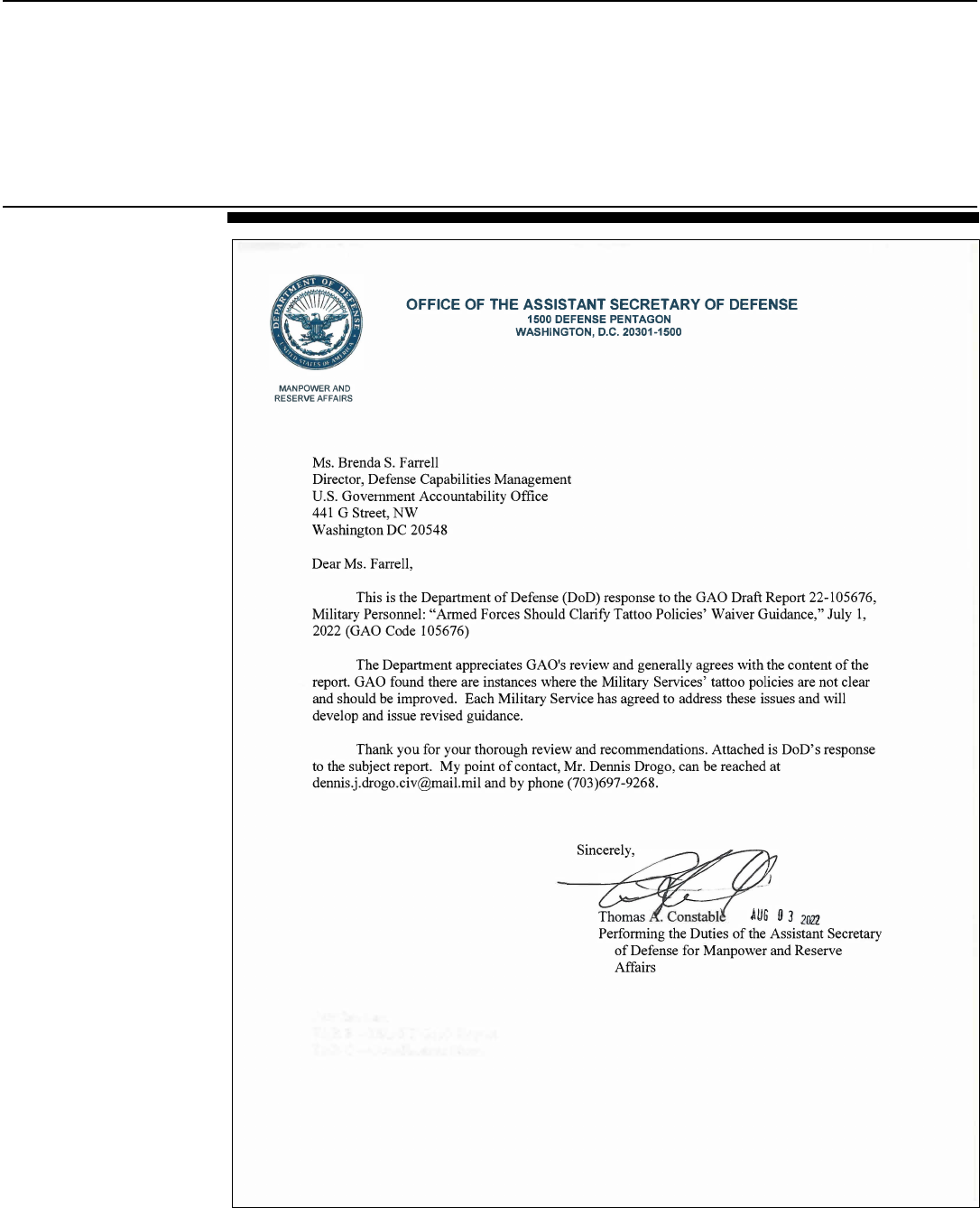
Appendix I: Comments from the Department of
Defense
Page 17 GAO-22-105676 Military Personnel
Appendix I: Comments from the Department
of Defense

Page 18 GAO-22-105676 Military Personnel
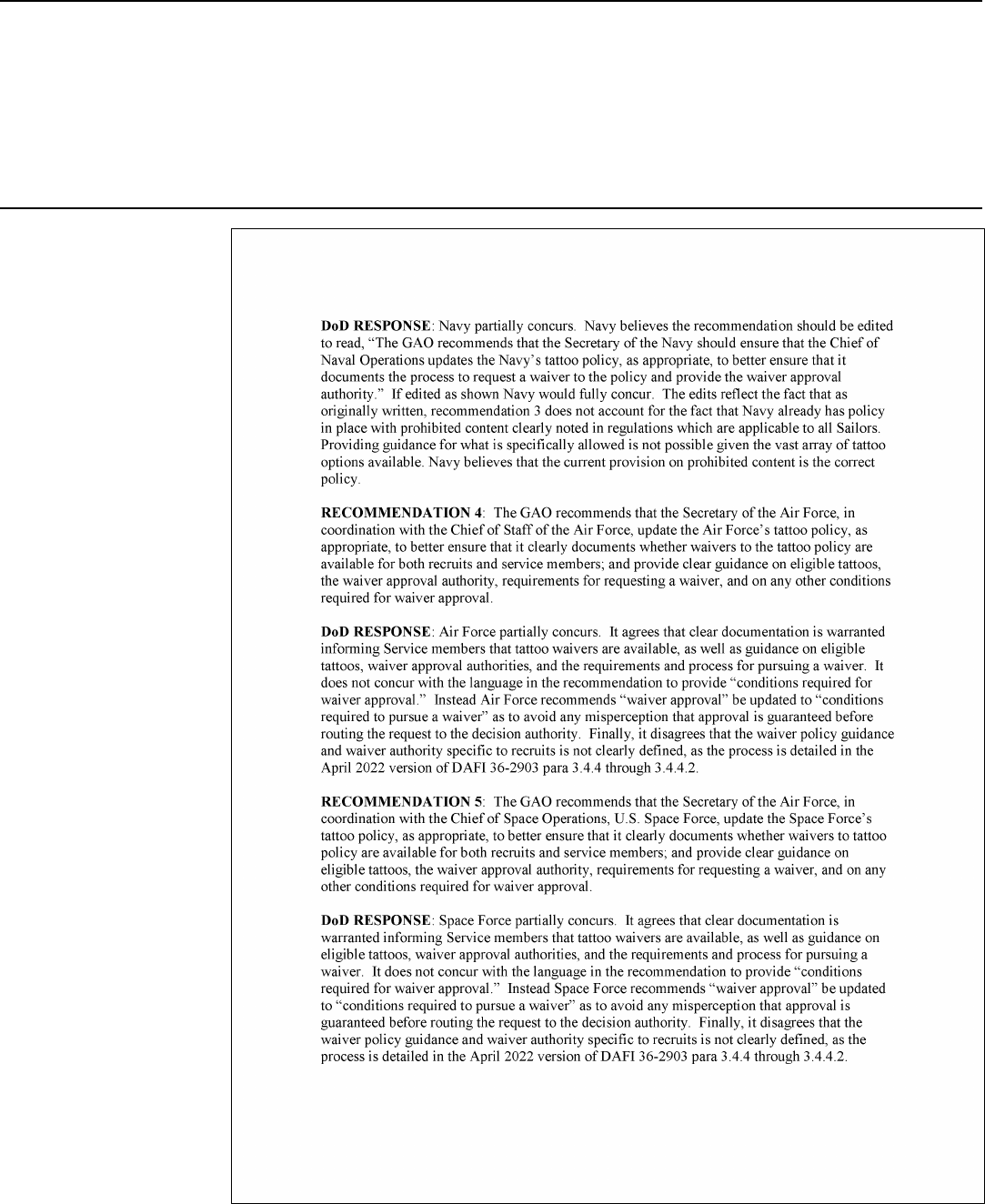
Page 19 GAO-22-105676 Military Personnel

Appendix II: Comments from the Department
of Homeland Security
Page 20 GAO-22-105676 Military Personnel
Appendix II: Comments from the Department
of Homeland Security
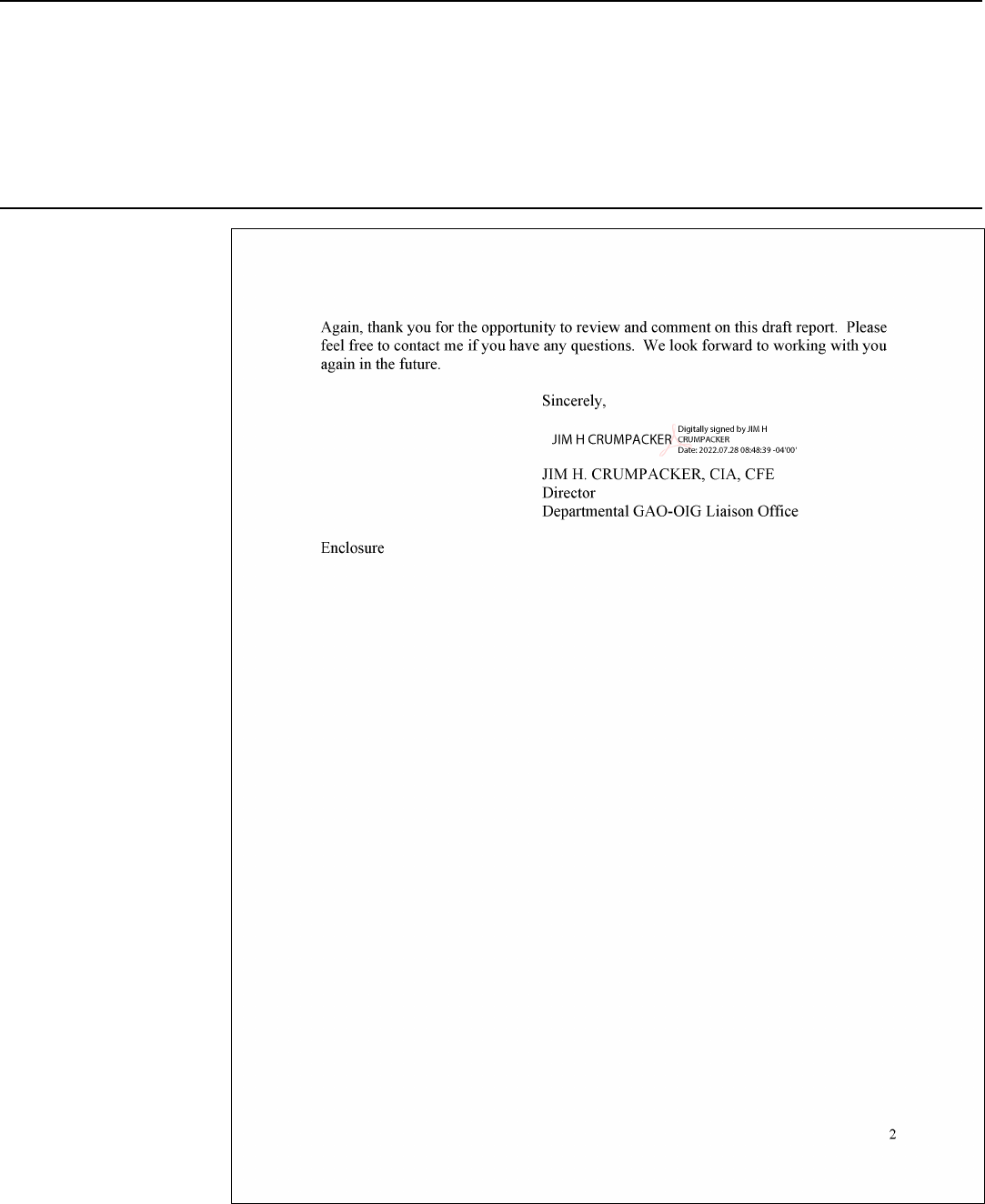
Appendix II: Comments from the Department
of Homeland Security
Page 21 GAO-22-105676 Military Personnel
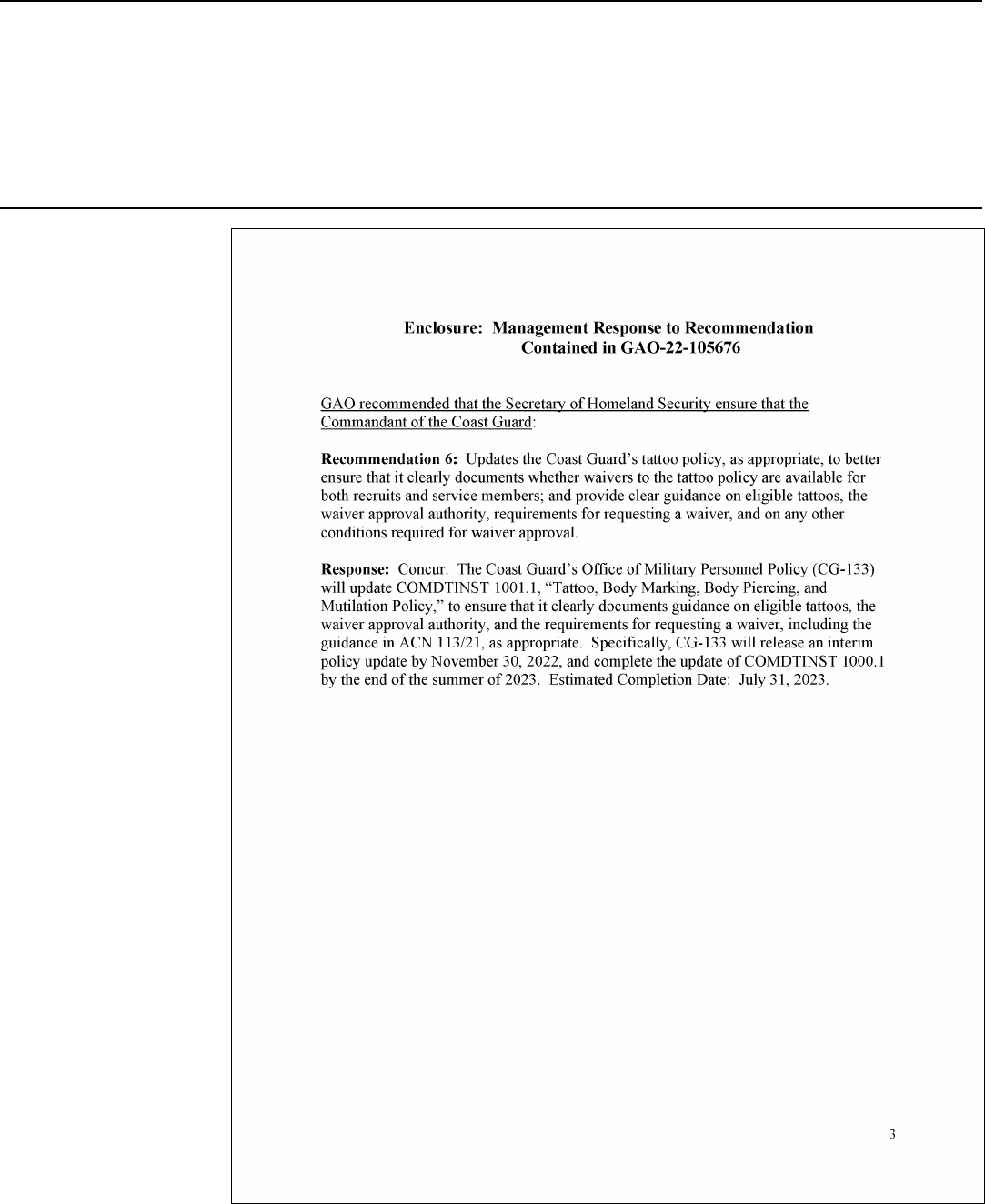
Appendix II: Comments from the Department
of Homeland Security
Page 22 GAO-22-105676 Military Personnel

Appendix III: GAO Contact and Staff
Acknowledgments
Page 23 GAO-22-105676 Military Personnel
In addition to the contact named above, GAO staff who made key
contributions to this report include Vincent Balloon (Assistant Director),
Rebekah J. Boone (Analyst-in-Charge), Vincent Buquicchio, David Jones,
Mae Jones, Suzanne Kaasa, and Stephanie Moriarty.
Appendix III: GAO Contact and Staff
Acknowledgments
GAO Contact
Staff
Acknowledgments
(105676)

The Government Accountability Office, the audit, evaluation, and investigative
arm of Congress, exists to support Congress in meeting its constitutional
responsibilities and to help improve the performance and accountability of the
federal government for the American people. GAO examines the use of public
funds; evaluates federal programs and policies; and provides analyses,
recommendations, and other assistance to help Congress make informed
oversight, policy, and funding decisions. GAO’s commitment to good government
is reflected in its core values of accountability, integrity, and reliability.
The fastest and easiest way to obtain copies of GAO documents at no cost is
through our website. Each weekday afternoon, GAO posts on its website newly
released reports, testimony, and correspondence. You can also subscribe to
GAO’s email updates to receive notification of newly posted products.
The price of each GAO publication reflects GAO’s actual cost of production and
distribution and depends on the number of pages in the publication and whether
the publication is printed in color or black and white. Pricing and ordering
information is posted on GAO’s website, https://www.gao.gov/ordering.htm.
Place orders by calling (202) 512-6000, toll free (866) 801-7077, or
TDD (202) 512-2537.
Orders may be paid for using American Express, Discover Card, MasterCard,
Visa, check, or money order. Call for additional information.
Connect with GAO on Facebook, Flickr, Twitter, and YouTube.
Subscribe to our RSS Feeds or Email Updates. Listen to our Podcasts.
Visit GAO on the web at https://www.gao.gov.
Contact FraudNet:
Website:
https://www.gao.gov/about/what-gao-does/fraudnet
Automated answering system: (800) 424-5454 or (202) 512-7700
A. Nicole Clowers, Managing Director, [email protected], (202) 512-4400, U.S.
Government Accountability Office, 441 G Street NW, Room 7125, Washington,
DC 20548
Chuck Young, Managing Director, young[email protected], (202) 512-4800
U.S. Government Accountability Office, 441 G Street NW, Room 7149
Washington, DC 20548
Stephen J. Sanford, Managing Director, [email protected]ov, (202) 512-4707
U.S. Government Accountability Office, 441 G Street NW, Room 7814,
Washington, DC 20548
GAO’s Mission
Obtaining Copies of
GAO Reports and
Testimony
Order by Phone
Connect with GAO
To Report Fraud,
Waste, and Abuse in
Federal Programs
Congressional
Relations
Public Affairs
Strategic Planning and
External Liaison
Please Print on Recycled Paper.
